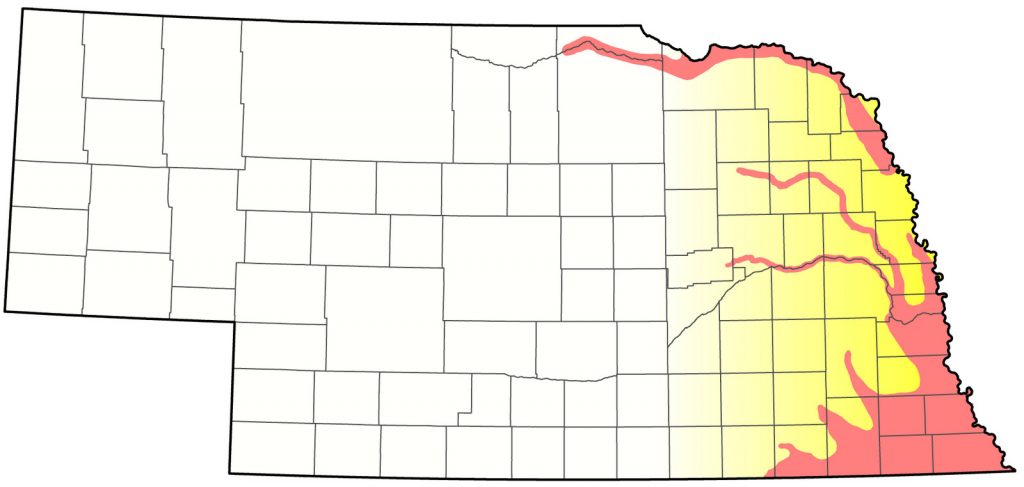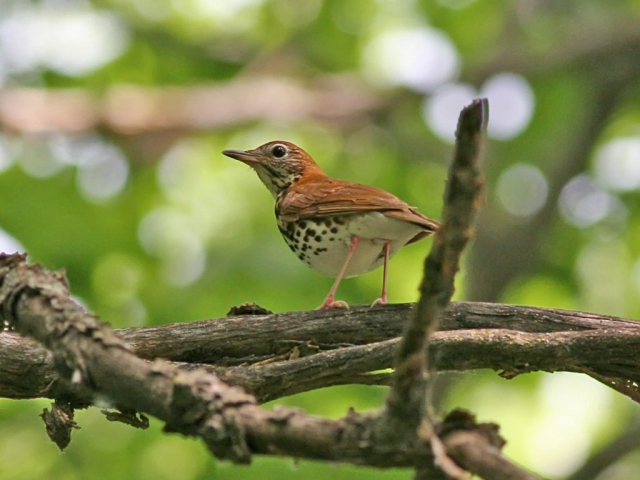Hylocichla mustelina
Status: Uncommon spring and fall migrant east, rare east central, rare casual west central and west. Uncommon breeder east and Niobrara River Valley west to include Holt and Boyd Cos.

Documentation: Specimen: UNSM ZM11015, 10 May 1911 Lincoln, Lancaster Co.
Taxonomy: No subspecies are recognized (AviList 2025).
Spring: Apr 26, 26, 27 <<<>>> summer
An earlier date is 21 Apr 2021.
It occurs regularly in migration in the east but is less than annual elsewhere (Rosche 1994, Jorgensen 2012). There are two documented Panhandle reports, a recording from Lisco, Garden Co 12 Jun 2018, and another recording from Old Stage Road, Scotts Bluff Co 3 Jun 2025. Documented reports in the central are 11 May 2024 Brown Co, 16 May 2003 Lincoln Co, 16 May 2018 Antelope Co, 17 May 2018 Boone Co, 17 May 2025 Holt Co, 18-19 May 2012 Sherman Co, 22 May 2019 Loup Co, 23 May 2006 Cherry Co, and 27 May 2016 Thomas Co.
We consider reports of this species prior to mid-Apr misidentified Hermit Thrushes.
- High counts: 34 at Indian Cave SP, Nemaha and Richardson Cos 11 May 2021, 19 there Richardson Co 19 May 2025, 17 at Indian Cave SP 14 May 2006, and 16 at Fontenelle Forest 12 May 2018.
Summer: Currently the breeding range of this species appears to be restricted mainly to the Missouri River Valley counties northwestward to the lower Niobrara River Valley in Knox Co and rarely to Brown Co. Since about 1950, this species has experienced significant range reduction by habitat loss in eastern Nebraska and apparently westward along the Platte River Valley, first by removal of the dominant American Elm by Dutch Elm Disease in the 1960s and 1970s, and more recently by accelerated removal of large timber stands along the Platte and Elkhorn rivers for agriculture, housing developments, and sand and gravel operations.
Brogie and Mossman (1983) considered it a “probable nester,” in the Niobrara Valley Preserve, where three singing males were found in Brown Co Jun-Jul 1982. Swenk found a Wood Thrush on a nest with three eggs in Long Pine Canyon in 1902 (Ducey 1983) and Short (1961) found Wood Thrush to be common in Holt Co along the Niobrara River in 1955. Youngworth (1955) found it a regular summer resident in northeast Cherry Co. These records indicate that Wood Thrush has probably nested in this area for some time, and possibly further west, as Short (1965) located a singing male along the Niobrara River about 20 miles west-southwest of Valentine in Cherry Co during the breeding season in 1965. There are additional summer records for Brown Co for most of the years 1964-72. Recent reports are few, however; Mollhoff (2016) showed no confirmed breeding west of Knox Co and only seven reports of “Possible” or “Probable” breeding, most during the 1984-1989 atlas period. More recently, westernmost records in the Niobrara River Valley are for Valentine Fish Hatchery, Cherry Co 23 May 2006, Avenue 470 in Boyd Co 12 Jul 2022, at Hutton Sanctuary, Rock Co 13 Jun 2019, and 7 Jul 2004 at Redbird Bridge Area, Holt Co.
Rosche (1982) considered it an accidental summer visitor in the northwest, citing one record only, a singing male in cottonwood forest on the edge of Box Butte Res, Dawes Co 19 Jun 1975. Mollhoff (2016) indicated single “Possible” breeding records in each of Sioux and Dawes Cos in the 1984-1989 atlas period. Ducey (1988) cited a statement in Bruner et al (1904) that breeding occurred in Sioux Co. No date or specific record was given; this was probably a late migrant.
There is a historical report of breeding in Antelope Co (Ducey 1988) but no reports since at least 1956 in summer for the upper Elkhorn River Valley; it breeds regularly west to Madison Co, including westernmost reports there 4 Aug 2000 Oak Valley WMA, two at Yellowbanks WMA 25 Jun 2012, 1-2 there 113 and 30 Jun 2021, and one there 25 Jul 2000.
Summer reports from the Loup River drainage are few: 16-18 Jun 1983 Boone Co, a nest in Nance Co in the period 1984-89 (Mollhoff 2001), a single in Nance Co 27 Jun 2000, and one at George Syas WMA, Platte Co 13 Jun and 21 Jul 2000. Short (1961) found four singing males on territory at NNF Bessey, Thomas Co Jun 1955, Glandon (1956) listed one record for Logan Co prior to 1955, although no details were given, a report from McPherson Co 16 Jun 1984, and in Thomas Co its status was listed as “uncertain, formerly a nesting species” (Bray 1994), but no details were provided. One was at NNF Bessey 27 May 2016.
In the Platte River Valley, it occurs each summer at Hormel Park, Fremont; one was on a nest there 9 May 2006 (Mollhoff 2006). The only reports further west in the Platte River Valley since the 1970s are of a recorded singer near Lisco, Garden Co 12 Jun 2018, at Rowe Sanctuary Buffalo Co 28 Jun 2004, in Merrick Co 18 Jul 2003, Nance Co 27 Jun 2000, and Platte Co 13 Jun-31 Jul 2000. Mollhoff (2016) showed a “Possible” breeding record in Butler Co in the 1984-1989 atlas period, and in the 2005-2011 atlas period, a total of six “Possible” records west of Butler Co and as far west as Gosper Co. An early report of nesting was an apparently successful nest in a Hastings, Adams Co yard in 1934 (Jones 1934). Tout found a nest in the York area around 1900 (Tout 1902, Jorgensen 2012, Mollhoff 2022).
Swenk (1919) called Wood Thrush an “abundant to common breeder over the state”, although evidence for this only applies to the Platte River Valley. Tout (1935) implied breeding in Lincoln Co; by 1947 he described Wood Thrush as a “regular summer resident” in Lincoln Co, present “every year in the big woods along the Platte River east of [North Platte]” (Tout 1947). Presumably these “big woods” were the Stenger Grove, described by Tout as located along the south side of the Platte River about 10 miles southeast of North Platte. Short (1961) found several territorial males west to Sutherland, Lincoln Co in 1956 and 1957, and Brown et al (1996) noted that a female with a brood patch was banded at Lake Ogallala, Keith Co 16 Jun. Short (1961) found individuals in the breeding season at various locations between Adams and Lincoln Cos in 1955-57, and there are a few summer reports for Adams Co 1964-76.
Until a Wood Thrush was observed nest-building at Wilderness Park, Lincoln, Lancaster Co 13 May 2023, nesting evidence was scarce since a few old records of nests with eggs in Lancaster Co 1889-1892 (Mollhoff 2022). Mollhoff (2016) showed single “Possible” breeding records in Lancaster Co for each of the 1984-1989 and 2006-2011 atlas periods, and a confirmed breeding record for the 2006-2011 atlas period. There are numerous reports however in Lancaster and nearby Seward Co; the four Seward Co records are 4 Jun 2022 (two records), 22 Jul 2010, and 13 Aug 2015, and in Lancaster Co there are about 23 Jun-Jul records, all since 2010, most in Wilderness Park, Lincoln.
The only indication that it might breed in summer in the drainages of the Big and Little Blue rivers or the Republican River Valley was Ludlow’s (1935) statement that the species was a “common summer resident” in Webster Co; no dates later than 20 May were listed, however. The only other reports suggestive of summering birds are of singles in Jefferson Co 18 May and 23 Jun 2016 and 28 Jun 2022, at Homestead NHP, Gage Co 15 Jul 2021 and 8 Jul 2022, at Red Cloud, Webster Co 27 Jun 2011, and in Gosper Co 2 Jul 2009. Additional reports, possibly migrants, for Gage Co are 8 May 2010, 15 May 1971, and 2 Jun 2018, and Webster Co 9 Jun 2009.
- Breeding phenology:
Nest building: 8-12 May
Eggs: 13 May- 31 Jul (Mollhoff 2022)
Nestlings: 3 Jun- 30 Jul
Fledglings: 12 Jun-11 Aug
- High counts: 15 at Indian Cave SP, Nemaha Co 17 Jul 2021, and 10 at Hummel Park, Douglas Co 8 Jun 2024.
Fall: summer <<<>>> Oct 2, 3, 4
Later dates are 8 Oct 2020 Lancaster Co, 21 Oct 2012 (photo) Boone Co, 22 Oct 2016 Sarpy Co, and 6 Nov 2024 one that hit a window, was photographed, recovered, and departed.
Migrants away from the breeding range are less-than-annual in occurrence; the only reports since 1990 are: 15 Sep 1997 NNF Bessey, and 5 Oct 2019 Adams Co.
Peak migration is probably in early Sep; departure is complete by late Sep.
We consider most reports after mid-Oct to be misidentified Hermit Thrushes.
- High counts: 6 at Platte River SP, Cass Co 7 Sep 2018.
Images
Abbreviations
NHP: National Historic Park
NNF: Nebraska National Forest
SP: State Park
UNSM: University of Nebraska State Museum
WMA: Wildlife Management Area (State)
Literature Cited
AviList Core Team, 2025. AviList: The Global Avian Checklist, v2025. https://doi.org/10.2173/avilist.v2025.
Bray, T.E. 1994. Habitat utilization by birds in a man-made forest in the Nebraska Sandhills. Master’s thesis, University of Nebraska-Omaha, Omaha, Nebraska, USA.
Brogie, M.A., and M.J. Mossman. 1983. Spring and summer birds of the Niobrara Valley Preserve, Nebraska: An annotated checklist. NBR 51: 44-51.
Brown, C.R., M.B. Brown, P.A. Johnsgard, J. Kren, and W.C. Scharf. 1996. Birds of the Cedar Point Biological Station area, Keith and Garden Counties, Nebraska: Seasonal occurrence and breeding data. Transactions of the Nebraska Academy of Sciences 23: 91-108.
Bruner, L., R.H. Wolcott, and M.H. Swenk. 1904. A preliminary review of the birds of Nebraska, with synopses. Klopp and Bartlett, Omaha, Nebraska, USA.
Ducey, J.E. 1983. Notes on the birds of the lower Niobrara River in 1902 as recorded by Myron H. Swenk. NBR 51: 37-44.
Ducey, J.E. 1988. Nebraska birds, breeding status and distribution. Simmons-Boardman Books, Omaha, Nebraska, USA.
Glandon, E.W. 1956. Birds that nest in the Stapleton area. NBR 24: 30.
Jones, A.H. 1934. Some notes on thrushes. NBR 2: 64.
Jorgensen, J.G. 2012. Birds of the Rainwater Basin, Nebraska. Nebraska Game and Parks Commission, Lincoln, Nebraska, USA.
Ludlow, C.S. 1935. A quarter-century of bird migration records at Red Cloud, Nebraska. NBR 3: 3-25.
Mollhoff, W.J. 2001. The Nebraska Breeding Bird Atlas 1984-1989. Nebraska Ornithologists’ Union Occasional Papers No. 7. Nebraska Game and Parks Commission, Lincoln, Nebraska, USA.
Mollhoff, W.J. 2006. The 2006 Nebraska nest report. NBR 74: 142-147.
Mollhoff, W.J. 2016. The Second Nebraska Breeding Bird Atlas. Bulletin of the University of Nebraska State Museum, Volume 29.
Mollhoff, W.J. 2022. Nest records of Nebraska birds. Nebraska Ornithologists’ Union Occasional Paper Number 9.
Rosche, R.C. 1982. Birds of northwestern Nebraska and southwestern South Dakota, an annotated checklist. Cottonwood Press, Crawford, Nebraska, USA.
Rosche, R.C. 1994. Birds of the Lake McConaughy area and the North Platte River valley, Nebraska. Published by the author, Chadron, Nebraska, USA.
Short, L.L., Jr. 1961. Notes on bird distribution in the central Plains. NBR 29: 2-22.
Short, L.L., Jr. 1965. Bird records from northern Nebraska during the breeding season. NBR 33: 2-5.
Swenk, M.H. 1919. The Birds and Mammals of Nebraska. Contributions of the Department of Entomology No. 23. Lincoln, Nebraska.
Tout, W. 1902. Ten years without a gun. Proceedings of Nebraska Ornithologists’ Union 3: 42-45.
Tout, W. 1935. The spread of the Wood Thrush to North Platte, Lincoln County. NBR 3: 28-29.
Tout, W. 1947. Lincoln County birds. Published by the author, North Platte, Nebraska, USA.
Youngworth, W. 1955. Some birds of the Quicourt Valley. NBR 23: 29-34.
Recommended Citation
Silcock, W.R., and J.G. Jorgensen. 2025. Wood Thrush (Hylocichla mustelina). In Birds of Nebraska — Online. www.BirdsofNebraska.org
Birds of Nebraska – Online
Updated 28 Aug 2025

